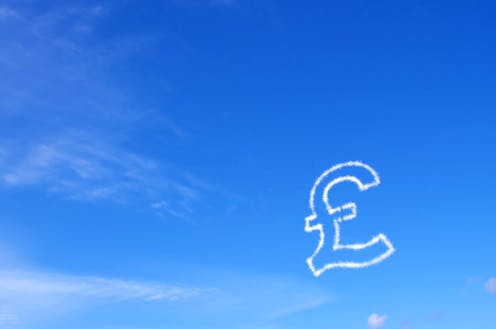Why the pound has shot up while UK economy is struggling – expert Q&A
- Written by Ganesh Viswanath-Natraj, Assistant Professor, Warwick Business School, University of Warwick

When Liz Truss and Kwasi Kwarteng’s tax-cutting mini-budget[1] triggered a UK debt crisis in autumn 2022, the pound plummeted to almost parity with the US dollar. In 2023 the UK has endured weak growth[2], falling productivity[3] and high inflation[4], yet the pound has been[5] the strongest performing currency among the G10 leading economies. It is currently trading at almost US$1.31, its highest level since April 2022.
To help understand what’s going on and where the pound goes from here, we spoke to Ganesh Vishwanath-Natraj, assistant professor of finance at the University of Warwick.
Many thought[6] last autumn that the pound would keep falling to dollar parity and below. What changed?
The Bank of England’s interest rate tightening[7] is probably the key factor. Though also the government’s fiscal policy has been more restrained.
Pound v US dollar 2021-23
But interest rates have been tightened in many countries. Why would it have made such a difference in the UK?
If you compare them to the US, for example, the federal funding rate has risen from basically 3% to 5% since last October. The equivalent UK rate has gone up from just over 2% to 5%. Not only has the UK tightened more, the markets expect[8] the Bank of England to keep tightening.
One reason for the stronger pound is that the US dollar has weakened over the same period. This may account for 50% of the change in the pound. Yet the pound has also gained against other currencies like the euro (rising from about €1.08 to €1.17 over the same period). This suggests that the pound’s appreciation is more likely due to UK policies than foreign factors.
Why has the US dollar been losing value?
The dollar is often seen as a measure of risk appetite – in other words, when the dollar is strong, there’s more pessimism in the global economy. The VIX index[9] is evidence for this: it is a measure of how much fear is in the market. Since October, it has fallen from about 32 to 14.
The US dollar over time
The whole de-dollarisation narrative[10] may also be having an effect. This is the idea that the dollar’s status as the world reserve currency is eroding because countries like China, Russia and Saudi Arabia have been turning away from the US currency. This is probably more of a long-term issue, but it may still be encouraging investors to short the dollar (bet that it will fall).
One other thing to note is that the falling dollar goes against inflation expectations. US inflation has been falling faster than in other countries, which all things being equal should cause the dollar to rise.
UK ten-year gilt yields are now higher than last autumn. Doesn’t that suggest sentiment about the UK has got worse?
The spike in gilt yields in autumn 2022 reflected investor panic after the mini-budget [gilts are bonds issued by the UK government to borrow money – the yields are the interest paid on the bonds; the higher the yields the lower the demand for the debt]. Yields fell back down to about 3% after the change of fiscal policy once Rishi Sunak became prime minister, which was probably the “correct” level for where interest rates were at the time. The rise in gilt yields since then reflects the rises in interest rates.
UK 10-year gilt yields







